Are you ready to dive into the fascinating world of wolves? Get ready to be awestruck as we explore the incredible size and power of the 10 largest wolves on the planet. From the ferocious Mongolian Wolf to the majestic Mackenzie Valley Wolf, these magnificent creatures will leave you spellbound. But hold on tight, because we’ve even got an honorable mention for the legendary Dire Wolf! So, grab a cup of coffee, sit back, and prepare to be amazed by these record-breaking wolves. Let’s embark on this wild journey together!
The Ten Largest Wolves on the Planet
Steeped in a rich tapestry of folklore and mythology, wolves are more than just symbols of strength or fear. These magnificent creatures, with their piercing eyes and powerful frames, represent a world of complexity and diversity that often goes unnoticed. Each species and subspecies of this majestic canid brings its own unique traits and characteristics to the pack, and size is one of the most awe-striking among them.
Humans have long been fascinated by the sheer size that some of these animals can grow to. Whether it’s the slender, long-legged wolves of the desert plains or the bulky, fur-covered giants of the Arctic, the size of these animals varies as much as the habitats they inhabit.
As we embark on this exploration of the largest wolves on the planet, we’ll delve into the world of these captivating canids, ranking them from the smallest to the largest. Prepare for a journey that will take us from the sun-scorched grasslands of Mongolia to the icy expanses of the Arctic, and many fascinating places in between.
So, without further ado, let’s dive into the world of the 10 largest wolves on the planet. Who knows what we might discover about these incredible, often misunderstood, creatures of the wild.
Unraveling the Mystique of the Mongolian Wolf
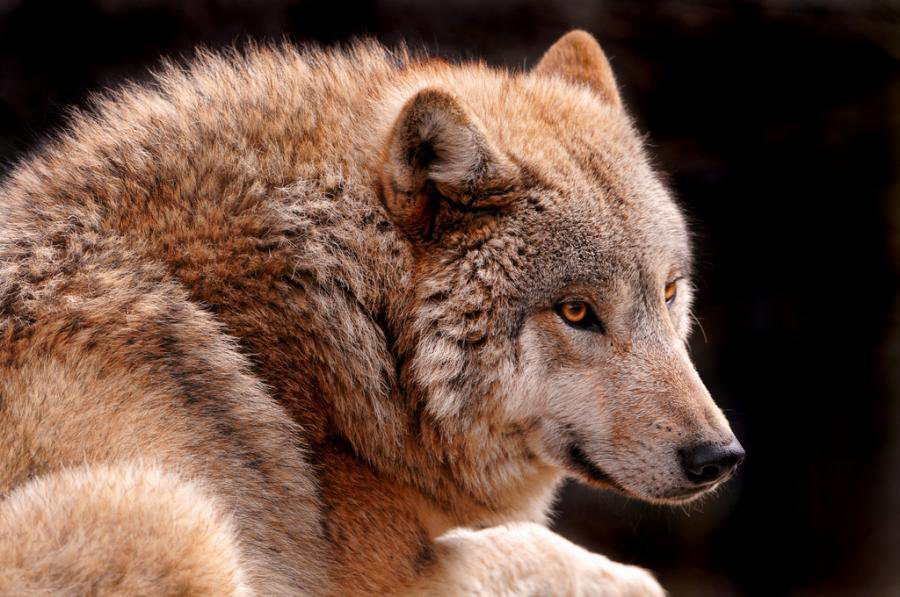
mongolian wolf
Embarking on our journey through the list of the planet’s largest wolves, let’s first turn our gaze towards the captivating Mongolian Wolf. This creature, also known by the alias Tibetan Wolf, effortlessly secures its place among the top ten largest wolves on the globe.
Native to the rugged terrains of Central Asia, the Mongolian Wolf roams expansively across the landscapes, from the windswept steppes of Mongolia to the frosty peaks of Northern China. Its striking presence is as vast as the territories it covers. The wolf measures an impressive 3 to 3.5 feet in length, the tail included, and stands at a commanding height of 24 to 38 inches at the shoulder.
The Mongolian Wolf, bearing the scientific name Canis lupus chanco, is a testament to nature’s adaptability, having evolved to thrive in the unforgiving, high-altitude environments of Central Asia.
The wolf’s weight, hovering between 55 to 77 pounds, may not seem extraordinarily large, but its lean and agile build is a natural adaptation to its high-altitude habitat. This creature’s thin frame is complemented by a dense, luxurious coat that serves as a crucial defense against the harsh cold.
Read all about: What Eats Tigers? Discover the Top Predators That Prey on Tigers
Surviving in such a challenging environment requires a certain degree of cunning and opportunism, traits not lost on the Mongolian Wolf. It primarily preys on the various ungulates found in the region, exploiting the abundant food resources available to sustain itself.
As we delve deeper into our exploration of the largest wolves on the planet, we’ll encounter other remarkable subspecies. Each one is a unique testament to the incredible diversity and adaptability of wolves worldwide.
Red Wolf: The Endangered Canid of the Southeastern United States
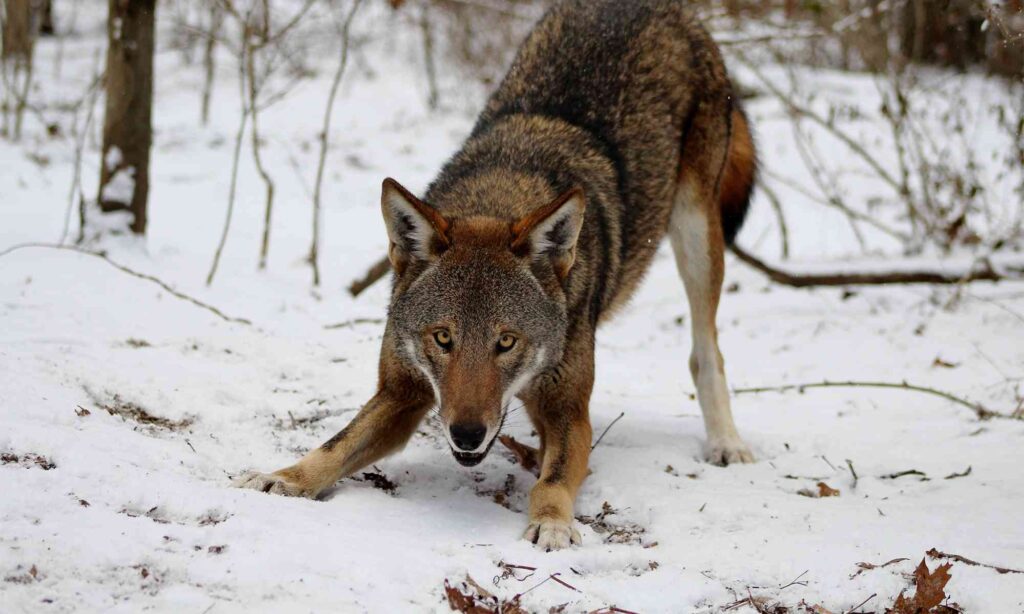
red wolf
As we journey from the rugged terrains of Asia, our next stop brings us to the southeastern regions of the United States. Here, we encounter a remarkable creature that carries with it a tale of survival against all odds – the Red Wolf.
Compared to its cousin, the Mongolian Wolf, the Red Wolf boasts a slightly larger body frame. With an impressive length ranging from 4.5 to 5.5 feet, this wolf stands at a height of 26 inches at the shoulder. Despite its larger physique, it weighs between 50 to 80 pounds, making it a lean and agile predator, much like its Asian counterpart.
Read about: Are Lions Friendly or Fierce? Unveiling the Truth about Their Nature and Interaction with Humans
What sets the Red Wolf apart, however, is its distinctive reddish-tawny fur. This unique coloration, reminiscent of a late-autumn sunset, not only gives it its name but also aids in its camouflage among the southeastern woodlands.
But beneath this stunning facade lies a somber reality. The Red Wolf is, in fact, one of the world’s most endangered canids. The haunting call of the Red Wolf, once familiar to the southeastern United States, is now a rare and poignant sound, echoing the struggle of this threatened species.
This resilient creature, however, continues to roam its natural habitat, reminding us of the intricate balance of the ecosystem and the urgent need for conservation efforts. The story of the Red Wolf is a testament to the enduring spirit of the wild and the delicate beauty of nature’s diversity.
As we continue our exploration of the largest wolves on the planet, let’s carry with us the tale of the Red Wolf – a story of survival, resilience, and the sheer power of nature.
Unveiling the Enigmatic Steppe Wolf

steppe wolf
Residing in the arid expanses of the Caspian steppes lies a remarkable creature, the Steppe Wolf. Striking a balance between agility and strength, this mid-sized subspecies is a testament to the resilience and adaptability of wolves around the globe.
Measuring between 3.5 to 5.5 feet in length, the Steppe Wolf stands erect at a height of 28 to 30 inches at the shoulder. Don’t let its size fool you, though. Despite weighing between 70 to 110 pounds, this canid is perfectly adapted to the challenging semi-desert environment it calls home.
Read all about: What is a Male Deer Called? Unveiling the Mystery of Male Deer Names
What distinguishes the Steppe Wolf from its northern counterparts are its physical adaptations. The Steppe Wolf boasts a lighter build, a trait that enables quick and rapid movements in pursuit of prey or while evading threats. Adding to its desert-ready features is its shorter fur, a vital characteristic that allows it to handle the searing heat of the steppes.
Speaking of prey, the Steppe Wolf is an expert hunter. Its diet primarily consists of various hoofed animals, and rodents, showcasing its predatory prowess and adaptability. The Steppe Wolf’s survival in such an environment is a testament to the wolf species’ enduring spirit and tenacity.
In the grand tapestry of wolf subspecies, the Steppe Wolf holds its own, showcasing the remarkable diversity of these majestic mammals. As we continue our journey through the world of the largest wolves, the Steppe Wolf stands as a reminder of the resilence and adaptability inherent in these incredible creatures. Stay tuned as we venture further into the wild and discover more of these fascinating subspecies.
The Mighty Tundra Wolf
Stepping into the icy expanses of Russia’s tundra and forest zones, we encounter the impressive Tundra Wolf (Canis lupus albus). Possessing an imposing stature, this wolf measures 5 to 7 feet in length, standing at a height of 35 inches at the shoulder. With a weight varying between 85 to 125 pounds, its formidable size is a testament to its strength and survival skills.
These majestic creatures are not just built for size, but for the extreme cold as well. They carry a dense, luxurious coat that serves as their personal shield against the freezing climate. Interestingly, their fur changes color as the seasons shift, a fascinating adaptation that aids in both hunting and camouflage. This transition from a lighter summer coat to a thicker, darker winter fur is a remarkable spectacle of nature’s ingenuity.
Check out: Are These the Most Stunning Pure White Animals You’ve Ever Seen?
Adapted to life in an extremely cold climate, the Tundra Wolves are a testament to the resilience and adaptability of the wolf species.
When it comes to sustenance, the Tundra Wolf is an opportunistic predator, demonstrating the classic wolf trait of versatility in their diet. They feed on a variety of animals, with a particular preference for large ungulates. This dietary preference showcases their hunting prowess and the crucial role they play in maintaining the balance of their ecosystem.
From their awe-inspiring size to their remarkable adaptability, the Tundra Wolf embodies the enduring spirit and diversity inherent in the world’s largest wolves. As we journey through the icy tundras, their story serves as a reminder of the delicate balance of nature and the importance of these apex predators in the ecosystem.
Also check out: Why Do Baboons Have Red Bottoms? Unveiling the Intriguing Mystery Behind Baboons’ Crimson Derrières
Stay tuned as we continue our exploration, venturing next into the frosty realms of the Canadian Arctic in search of the enigmatic Arctic Wolf.
The Majestic Arctic Wolf
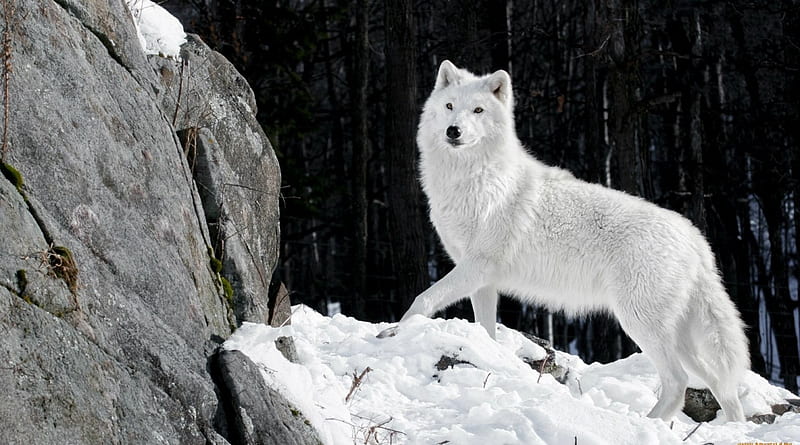
artic wolf
Imagine a landscape, a frozen sea of white stretching as far as the eye can see. The air is so cold it catches your breath, and the silence is only broken by the crunch of snow underfoot. This is the realm of the Arctic Wolf. A wolf not just adapted, but perfectly carved out for the icy expanse of the Canadian Arctic Archipelago.
Measuring between 3.9 to 5.9 feet in length, the Arctic Wolf is a majestic sight to behold. Its stature is further emphasized by its height of 25 to 31 inches at the shoulder. The weight of this icy sentinel ranges between 70 to 125 pounds. To say it’s a large creature would be an understatement; it’s a formidable creature that commands respect.
What separates the Arctic Wolf from its relatives is its remarkable adaptation to the frigid environment. Its coat is denser and thicker than any other wolf species’, a testament to the harsh conditions it endures. A thick fur that acts as an insulating layer, shielding it from the biting cold, is an emblem of its survival.
The Arctic Wolf is not just a survivor but a hunter par excellence. It primarily preys on muskoxen and Arctic hares, a testament to its hunting prowess. However, food in the Arctic is not always plentiful. This wolf is known to travel long distances in search of sustenance, showcasing its perseverance and tenacity.
The Arctic Wolf’s story is a testament to the ability of wolves to adapt and thrive in even the harshest of environments. A symbol of resilience and endurance, the Arctic Wolf stands as a fascinating chapter in the narrative of the world’s largest wolves.
Unraveling the Majesty of the Northern Rocky Mountains Wolf
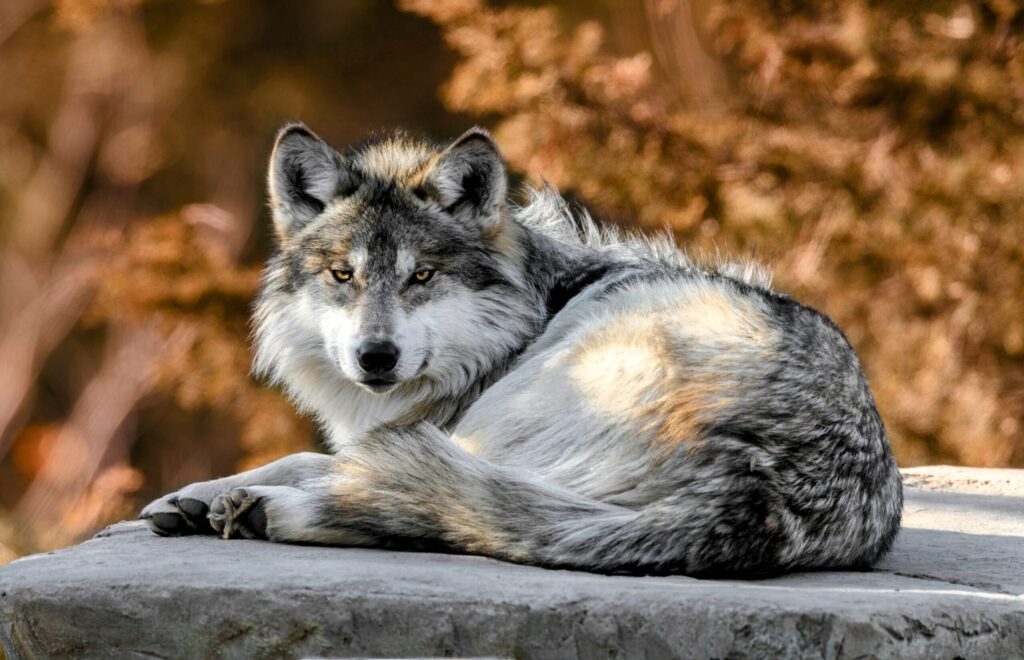
northern rocky mountains wolf
As we traverse the frosty planes of the Arctic, we journey next into the rugged terrains of the Northern Rocky Mountains. Here, we encounter the imposing figure of the Northern Rocky Mountains Wolf. This remarkable creature boasts a length of approximately 4.5 to 6.5 feet, including its tail, and stands proudly at 28 to 31 inches at the shoulder.
Imagine the majestic sight of this wolf, its impressive stature accentuated by a weight ranging between 70 to 115 pounds. A cloak of gray, black, and rust-colored fur adorning its body, serves not just as a shield against the harsh climes, but also as an artistic palette that mirrors the hues of the surrounding wilderness.
Adapted to the rocky and uneven landscapes of the Northern Rocky Mountains, the Northern Rocky Mountains Wolf is a picture of adaptability and survival in the face of adversity.
Not just a formidable sight to behold, the Northern Rocky Mountains Wolf is also an efficient and skilled hunter. It utilizes its keen senses and agility to take down a variety of game, from the massive elk and moose to smaller, agile prey. This wolf embodies the relentless spirit of survival, demonstrating remarkable resilience in the face of varied challenges presented by its environment.
As we delve into the world of the Northern Rocky Mountains Wolf, we learn that it is not just its size or hunting prowess that sets it apart. It’s a testament to the incredible adaptability and endurance of wolves, a trait that we’ve seen echoed in its Arctic and Tundra counterparts.
The Northern Rocky Mountains Wolf is a captivating chapter in our exploration of the largest wolves on the planet, a tale of resilience and adaptability woven into the rugged landscapes of the Northern Rockies.
The Alaskan Interior Wolf: The Agile Endurance Runner of the North
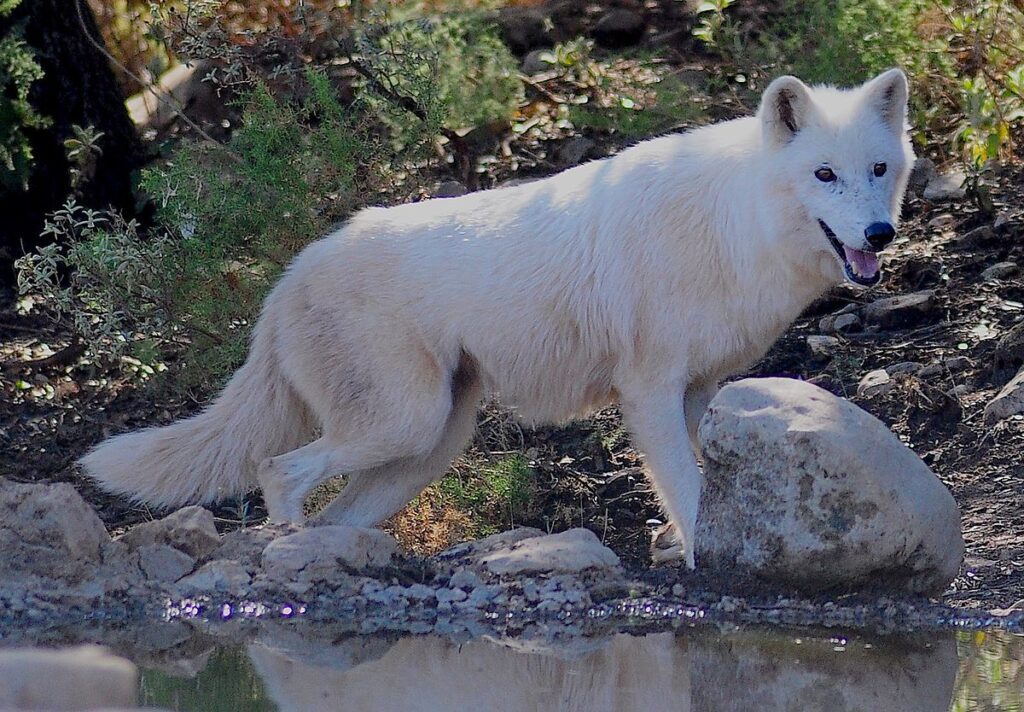
alaskan wolf
Travel with me now to the vast expanses of Alaska and Yukon, home to our next majestic creature, the Alaskan Interior Wolf. With a length that spans between 4.5 to 6.5 feet, this wolf is a sight to behold. When standing on all fours, this wolf commands attention, reaching an impressive height of 30 to 32 inches at the shoulder.
Unlike its coastal cousins, the Alaskan Interior Wolf possesses a lighter build, tipping the scales between 85 to 115 pounds. This lean structure is a testament to its adaptability, allowing the wolf to navigate the diverse inland landscapes of Alaska with agility and grace.
Its survival in the harsh Alaskan interior is a testament to the endurance and resilience that is characteristic of its species. Just as the Arctic Wolf thrives in the icy Canadian Arctic Archipelago, and the Northern Rocky Mountains Wolf masters the rocky terrains, the Alaskan Interior Wolf has carved out a niche for itself amidst Alaska’s vast wilderness.
The diet of the Alaskan Interior Wolf is a reflection of its environment. This agile hunter predominantly feeds on moose and caribou, which are abundant in its territory. This dietary adaptation allows the wolf to survive and thrive in a region where food sources can sometimes be scarce, particularly during the harsh winters.
Check out: Are Cheetahs Dangerous? Discover the Truth About Cheetah Attacks and Their Appetite for Humans
This wolf’s remarkable survival skills, combined with its impressive size, earns it a rightful place among the largest wolves on the planet.
The Legacy of the Great Plains Wolf
In the diverse tapestry of North America’s wildlife, a critical thread was once woven by the Great Plains Wolf. This majestic creature, now largely vanished from the wild, was a significant figure in the wilderness of central North America. With a length of 4.6 to 6.6 feet and standing at a height of 30 to 34 inches at the shoulder, this wolf was not as large as the Northern Rocky Mountains Wolf or the Alaskan Interior Wolf, but its presence was no less significant.
Typically weighing between 85 to 110 pounds, the Great Plains Wolf was smaller than its northern relatives but held a commanding presence with its robust built. Its unique physique was a testament to the survival and adaptability of the wolf species in the diverse landscapes of the American Midwest and Great Plains.
As an apex predator, the Great Plains Wolf played a vital role in maintaining the balance of its ecosystem. It primarily hunted bison, contributing to the control of these large herbivores and thereby mitigating overgrazing.
The Great Plains Wolf’s resilience and adaptability were a reflection of the wild spirit of the American Midwest and Great Plains.
However, the story of the Great Plains Wolf is also a cautionary tale. In the 19th and 20th centuries, widespread eradication efforts led to its near extinction. The disappearance of this once prolific wolf serves as a stark reminder of the impact humans can have on wildlife and the importance of conservation efforts.
Check out: What Animals Eat Snakes? Discover the Top 12 Snake Predators in the Wild
Yet, the legacy of the Great Plains Wolf is not wholly a tale of loss. Its story continues to inspire efforts to reestablish wolf populations in areas where they have been eradicated. As we delve deeper into the lives of the largest wolves on the planet, let’s remember the Great Plains Wolf’s valuable contribution to our ecosystem, and the lessons learned from its decline.
The Versatile and Widespread Eurasian Wolf

eurasian wolf
Occupying an impressive second place in our rundown of the planet’s largest wolves, we encounter the mighty Eurasian Wolf. This wolf, known scientifically as ‘Canis lupus lupus’, presides over a vast territory encompassing much of Eurasia. Its body, a remarkable blend of power and agile grace, measures from 3.9 to an astounding 6.8 feet in length. When standing, it reaches a height of 31 to 33 inches at the shoulder, its keen eyes scanning the horizon for its next meal.
This majestic beast, the Eurasian Wolf, is not just known for its size, but also for its adaptability. This trait has allowed it to become the most widely distributed subspecies of wolf, making its home in a myriad of climates and landscapes. From the chilling tundra to the dense forests, and even the arid deserts, the Eurasian Wolf stands as a testament to nature’s resilience.
Such a diverse range of habitats comes with an equally diverse diet. The Eurasian Wolf’s menu varies significantly based on its surroundings. It primarily preys on ungulates – large, hoofed animals like deer and elk. However, it also supplements its diet with smaller creatures like rodents and, in coastal areas, does not shy away from a seafood feast.
Despite its ferocity and size, the Eurasian Wolf remains a creature of mystery and intrigue, symbolizing both the raw power and the adaptable spirit of the wild. In the next section, we will continue our exploration of these magnificent creatures, focusing on the imposing Mackenzie Valley Wolf. Stay tuned!
The Majestic Mackenzie Valley Wolf: The Reigning Titan of North America
At the zenith of our roster of the planet’s most colossal wolves is the awe-inspiring Mackenzie Valley Wolf. Also known as the Northwestern Wolf or Alaskan Timber Wolf, this magnificent creature is a marvel in the wolf species, holding its own even amongst its impressive relatives from the Great Plains and Eurasia.
Residing in the western regions of North America, the Mackenzie Valley Wolf commands an expansive territory that stretches from the frosty landscapes of Alaska, through the wilderness-rich western Canadian provinces, and into the northwestern United States. This geographical spread serves as a testament to the wolf’s adaptability and resilience, echoing the qualities of its Great Plains and Eurasian cousins.
Boasting an impressive length of 5 to 7 feet from nose to tail-tip and standing tall at a shoulder height of 33 to 36 inches, this wolf’s physique is as impressive as its geographical range. With a weight that oscillates between 100 to 145 pounds, the Mackenzie Valley Wolf is one of the most formidable subspecies of the Gray Wolf.
But it’s not just the size that makes this wolf stand out. Adapted to varied environments, it thrives in the heart of forests, the rugged terrains of mountains, and the icy expanses of tundras. It is a testament to the robust survival instincts embedded in the genetic makeup of this remarkable creature.
The Mackenzie Valley Wolf is a skilled predator, capable of taking down sizeable prey like moose and bison. Its hunting prowess allows it to maintain the delicate balance of the ecosystems it inhabits, echoing once more the ecological role played by its Great Plains predecessor.
In the grand tapestry of the wolf kingdom, the Mackenzie Valley Wolf is a true titan, embodying the enduring spirit of the wild. Its presence serves as a reminder of the diverse and adaptable nature of the wolf species, a trait we shall continue exploring as we journey through our list of the ten largest wolves on the planet.
Honorable Mention: The Dire Wolf

dire wolf
In the annals of wolf history, there exists a chapter that spans from 125,000 to 9,500 years ago during the Late Pleistocene epoch. This was the era of the Dire Wolf, a creature of legend and an extinct species of the genus Canis. The Dire Wolf, whose name means “fearsome dog,” left an indelible mark in the fossil records and the collective imagination of mankind.
These formidable creatures once roamed the verdant landscapes of North America, extending their reach to parts of South America. They were a testament to the raw, untempered power of nature, larger and more fearsome than their modern counterparts. The Dire Wolf was an apex predator, its size allowing it to take down large Pleistocene megafauna, such as bison and mastodons, crucial for survival in their harsh, unforgiving environment.
“The Dire Wolf was larger than most modern wolf species, an embodiment of the untamed wilderness of the Pleistocene era.”
Estimates based on the whispers of fossil records paint a picture of a wolf of imposing stature. The Dire Wolf weighed between 130 to 150 pounds, standing about 2.5 feet tall at the shoulder. Its length, measuring approximately 5 feet, further emphasized its raw, primal power. This robust body size allowed the Dire Wolf to command the ecosystems of the Late Pleistocene, maintaining a delicate balance between predator and prey.
However, despite their impressive size and hunting prowess, the Dire Wolf could not withstand the test of time. They eventually succumbed to the Quaternary extinction event, their thunderous howls fading into the echoes of the past.
While the Dire Wolf may not roam the earth today, its legacy endures. Its story serves as a stark reminder of the impermanence of life and the eternal struggle for survival. The Dire Wolf, a fearsome dog from a bygone era, undoubtedly deserves an honorable mention when discussing the largest wolves on our planet.
Record-Breaking Wolves: Tales of Titans in the Wilderness
As we venture deeper into the realm of the largest wolves ever known, a sense of wonder and intrigue fills the air. The mesmerizing tales of these legendary canids, both terrifying and awe-inspiring, continue to captivate us. The stories of the largest wolves ever recorded are not just about numbers and measurements, but about the remarkable adaptability and survival prowess of these magnificent creatures. Let’s dive into the accounts of two such legendary wolves.
The first tale takes us back to the frosty wilderness of Alaska in 1939. Amidst the icy landscapes, a wolf of truly exceptional size was reportedly killed. This majestic Alaskan titan measured an astounding 7.6 feet in length and tipped the scales at a hefty 175 pounds. The sheer size of this wolf, much larger than the average Gray Wolf, paints a vivid picture of a formidable predator roaming the vast terrains of Alaska. These measurements, while not typical, offer a glimpse into the potential size wolves can reach under optimal conditions.
Another story that often emerges in discussions about the largest wolves originates from Drayton Valley, Alberta. In 1967, a wolf allegedly weighing 235 pounds was killed. This account, however, is shrouded in controversy, with not all scientists universally accepting this record. Doubts persist regarding potential inaccuracies in the reported weight of this wolf. Despite the ongoing debate, this story testifies to the compelling allure that these large wolves hold over our imagination.
It’s essential to remember that these examples are outliers, extraordinary individuals that grew far beyond the average size of their species. The typical mature male Gray Wolf, depending on its subspecies and region, generally weighs between 70 to 145 pounds. These record-breaking wolves, with their impressive sizes, serve as remarkable exceptions that underscore the diversity and adaptability within the wolf species.
As we marvel at these tales of record-breaking wolves, let’s remember that every wolf, regardless of its size, plays a crucial role in maintaining the delicate balance of their respective ecosystems. These stories not only illuminate the fascinating world of wolves but also remind us of our responsibility to protect and preserve these incredible creatures for future generations to admire and learn from.
Conclusion
In the heart of deep forests, over vast steppes, and across icy tundras, wolves roam, a testament to nature’s versatility and resilience. They are creatures of immense diversity, each species and subspecies perfectly tailored to thrive in their unique corners of the world. Their size, while impressive, is but one facet of their complex existence. As we dive deeper into the world of wolves, we begin to unravel the threads of their intricate tapestry of life.
Just as the Dire Wolf of eons past, with its formidable size and hunting prowess, left an indelible mark on our planet’s history, so too do our contemporary wolves influence our ecosystems. From the majestic Mackenzie Valley Wolf ruling the wild expanses of western Canada, to the agile Red Wolf navigating the forests of the southeastern United States, each wolf holds a vital role in maintaining nature’s delicate balance.
Their size does more than just command awe; it equips them to take down sizeable prey, from nimble deer to mighty moose. This in turn controls the populations of these herbivores, ensuring that our forests and grasslands do not become overgrazed. Wolves are thus the unseen gardeners of our planet, sculpting landscapes with their hunting strategies.
Yet, wolves are not just ecological factors; they are sentient beings with unique behaviors and social structures. Their howl echoing in the wilderness is not just a chilling sound, but a complex form of communication, a testament to their social sophistication. Their presence in our folklore and mythology is a reflection of our deep-rooted fascination and respect for these creatures.
With every discovery about these remarkable creatures, our understanding deepens, and our appreciation for their role in our world grows. The study of the ten largest wolves on our planet is not merely an exploration of their physicality, but a celebration of their ecological importance, their behavioral uniqueness, and their cultural significance. As we delve into their world, we are reminded of our responsibility to conserve and protect these magnificent beings, ensuring that their howls continue to echo through our wilderness for generations to come.
One of the most striking features of wolves is their size, which varies across different types.
The wolves will be ranked from smallest to largest in the article.
The Mongolian Wolf, also known as the Tibetan Wolf, is one of the top 10 largest wolves.
The Mongolian Wolf has a length of 3 to 3.5 feet (including tail), stands at a height of 24 to 38 inches at the shoulder, and weighs from 55 to 77 pounds.

